The length of the median BD in triangle ABC is 12 centimeters, what is the length of side AC?
(1) ABC is an isosceles triangle
(2) AC^2 = AB^2 + BC^2
[spoiler]OA: B[/spoiler]
source: Gmatclub Maths Tests
median in triangle
This topic has expert replies
- MartyMurray
- Legendary Member
- Posts: 2131
- Joined: Mon Feb 03, 2014 9:26 am
- Location: https://martymurraycoaching.com/
- Thanked: 955 times
- Followed by:140 members
- GMAT Score:800
Well I messed around with this.buoyant wrote:The length of the median BD in triangle ABC is 12 centimeters, what is the length of side AC?
(1) ABC is an isosceles triangle
(2) AC^2 = AB^2 + BC^2
[spoiler]OA: B[/spoiler]
First I took care of Statement 1. For one thing it does not say which of the sides are equal, or much else. So we can't figure out the relationship between the length of the median and that of the side AC.
Insufficient
Statement 2 is interesting. From the equation we can tell that ABC is a right triangle with AC as the hypotenuse, because the squares of the lengths of the other two sides add up to the square of AC. Then I played with some different triangles. If ABC is a 45-90-45 triangle, the median extends down and creates two new 45-45-90 triangles. The two equal sides of each of these triangles are the median and half of AC. So if the length of the median is half of AC, then AC = 2 * 12 = 24.
Alternatively if ABC is a 30-90-60 triangle, the median will form an equilateral, 60-60-60, triangle and a 30-120-30 triangle. Hmm. So once again the median is half of AC and so AC is 24.
So I am guessing that with some more math we will discover that a median extending from the right angle of a right triangle always forms two isosceles triangles with one of the two equal sides of each triangle being the median and the other being half the hypotenuse.
Yup, I looked it up, and by inscribing the right triangle in a circle we can show that the median is always half the hypotenuse.
So Statement 2 is sufficient and the answer is B.
Having said that, I somehow doubt having to prove a geometric rule in this way would be necessary to answer a two minute GMAT question, and further, I don't believe this rule is part of the body of knowledge one is expected to know in order to have the basis for answering GMAT questions.
In other words, while that rule might occasionally be useful in answering a GMAT question, one does not need to know it or derive it to solve GMAT problems.
Maybe someone else will have a different opinion, but that's my take. In a way it's a cool question, and maybe something to learn from, but that's it.
Marty Murray
Perfect Scoring Tutor With Over a Decade of Experience
MartyMurrayCoaching.com
Contact me at [email protected] for a free consultation.
Perfect Scoring Tutor With Over a Decade of Experience
MartyMurrayCoaching.com
Contact me at [email protected] for a free consultation.
- GMATGuruNY
- GMAT Instructor
- Posts: 15539
- Joined: Tue May 25, 2010 12:04 pm
- Location: New York, NY
- Thanked: 13060 times
- Followed by:1906 members
- GMAT Score:790
This problem seems beyond the scope of the GMAT.buoyant wrote:The length of the median BD in triangle ABC is 12 centimeters, what is the length of side AC?
(1) ABC is an isosceles triangle
(2) AC² = AB² + BC²
The MEDIAN of a triangle is a line drawn from a vertex to the MIDPOINT of the opposite side.
Statement 1: ABC is an isosceles triangle
Here, ∆ABC could take on many sizes.
Two examples:
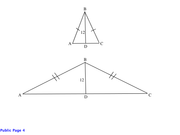
AC is short in the top triangle but long in the bottom triangle.
Implication:
The length of AC cannot be determined.
INSUFFICIENT.
Statement 2: AC² = AB² + BC²
Implication:
∆ABC is a RIGHT TRIANGLE, with AC as the hypotenuse.
Rule:
A median drawn to the hypotenuse of a right triangle forms TWO ISOSCELES TRIANGLES, as in the following figure:
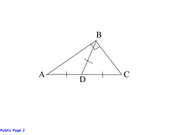
Thus, BD=AD=DC=12.
Thus, AC = AD+DC = 12+12 = 24.
SUFFICIENT.
The correct answer is B.
Another helpful rule:
The median of a triangle forms two triangles of EQUAL AREAS.
Thus, in statement 2, the area of ∆ABD is equal to the area of ∆BCD.
This concept is tested by DS119 in the OG13:
https://www.beatthegmat.com/data-suffici ... 85748.html
Private tutor exclusively for the GMAT and GRE, with over 20 years of experience.
Followed here and elsewhere by over 1900 test-takers.
I have worked with students based in the US, Australia, Taiwan, China, Tajikistan, Kuwait, Saudi Arabia -- a long list of countries.
My students have been admitted to HBS, CBS, Tuck, Yale, Stern, Fuqua -- a long list of top programs.
As a tutor, I don't simply teach you how I would approach problems.
I unlock the best way for YOU to solve problems.
For more information, please email me (Mitch Hunt) at [email protected].
Student Review #1
Student Review #2
Student Review #3
Followed here and elsewhere by over 1900 test-takers.
I have worked with students based in the US, Australia, Taiwan, China, Tajikistan, Kuwait, Saudi Arabia -- a long list of countries.
My students have been admitted to HBS, CBS, Tuck, Yale, Stern, Fuqua -- a long list of top programs.
As a tutor, I don't simply teach you how I would approach problems.
I unlock the best way for YOU to solve problems.
For more information, please email me (Mitch Hunt) at [email protected].
Student Review #1
Student Review #2
Student Review #3
Hi Mitch,GMATGuruNY wrote:This problem seems beyond the scope of the GMAT.buoyant wrote:The length of the median BD in triangle ABC is 12 centimeters, what is the length of side AC?
(1) ABC is an isosceles triangle
(2) AC² = AB² + BC²
The MEDIAN of a triangle is a line drawn from a vertex to the MIDPOINT of the opposite side.
Statement 1: ABC is an isosceles triangle
Here, ∆ABC could take on many sizes.
Two examples:
AC is short in the top triangle but long in the bottom triangle.
Implication:
The length of AC cannot be determined.
INSUFFICIENT.
Statement 2: AC² = AB² + BC²
Implication:
∆ABC is a RIGHT TRIANGLE, with AC as the hypotenuse.
Rule:
A median drawn to the hypotenuse of a right triangle forms TWO ISOSCELES TRIANGLES, as in the following figure:
Thus, BD=AD=DC=12.
Thus, AC = AD+DC = 12+12 = 24.
SUFFICIENT.
The correct answer is B.
Another helpful rule:
The median of a triangle forms two triangles of EQUAL AREAS.
Thus, in statement 2, the area of ∆ABD is equal to the area of ∆BCD.
This concept is tested by DS119 in the OG13:
https://www.beatthegmat.com/data-suffici ... 85748.html
can the median also be perpendicular bisector? is it the case here or is an unrelated concept altogether?
i used similar triangle concept to prove AC = 2*BD (assumed the median made 90 degree at the point of intersection at the base.
GMAT/MBA Expert
- [email protected]
- Elite Legendary Member
- Posts: 10392
- Joined: Sun Jun 23, 2013 6:38 pm
- Location: Palo Alto, CA
- Thanked: 2867 times
- Followed by:511 members
- GMAT Score:800
Hi buoyant,
What is the source of this question?
GMAT assassins aren't born, they're made,
Rich
What is the source of this question?
GMAT assassins aren't born, they're made,
Rich
- GMATGuruNY
- GMAT Instructor
- Posts: 15539
- Joined: Tue May 25, 2010 12:04 pm
- Location: New York, NY
- Thanked: 13060 times
- Followed by:1906 members
- GMAT Score:790
Only in an ISOSCELES triangle can a median be a perpendicular bisector, as shown in my illustrations for Statement 1:Hi Mitch,
can the median also be perpendicular bisector? is it the case here or is an unrelated concept altogether?
i used similar triangle concept to prove AC = 2*BD (assumed the median made 90 degree at the point of intersection at the base.

Since statement 2 does not indicate that ∆ABC is isosceles, we cannot assume that median BD is a perpendicular bisector of AC.
A valid way to prove that Statement 2 is SUFFICIENT:
According to the prompt, median BD = 12.
According to statement 2, AC² = AB² + BC².
Since median BD extends from B to the MIDPOINT of opposite side AC, and statement 2 indicates that ∆ABC is a RIGHT TRIANGLE, the following figure is implied:
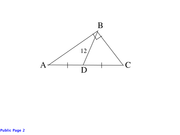
If a right triangle is inscribed in a circle, the hypotenuse is a DIAMETER of the circle:
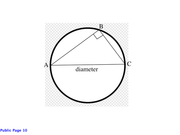
Thus, if right triangle ABC -- along with median BD -- is inscribed in a circle, the following figure is yielded:
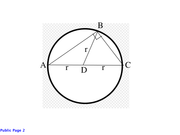
Since hypotenuse AC is a diameter, and median BD bisects AC, D is the center of the circle.
Thus, BD, AD, and DC are all radii, implying that BD=AD=DC.
Since radius BD = 12, diameter AC = 24.
Private tutor exclusively for the GMAT and GRE, with over 20 years of experience.
Followed here and elsewhere by over 1900 test-takers.
I have worked with students based in the US, Australia, Taiwan, China, Tajikistan, Kuwait, Saudi Arabia -- a long list of countries.
My students have been admitted to HBS, CBS, Tuck, Yale, Stern, Fuqua -- a long list of top programs.
As a tutor, I don't simply teach you how I would approach problems.
I unlock the best way for YOU to solve problems.
For more information, please email me (Mitch Hunt) at [email protected].
Student Review #1
Student Review #2
Student Review #3
Followed here and elsewhere by over 1900 test-takers.
I have worked with students based in the US, Australia, Taiwan, China, Tajikistan, Kuwait, Saudi Arabia -- a long list of countries.
My students have been admitted to HBS, CBS, Tuck, Yale, Stern, Fuqua -- a long list of top programs.
As a tutor, I don't simply teach you how I would approach problems.
I unlock the best way for YOU to solve problems.
For more information, please email me (Mitch Hunt) at [email protected].
Student Review #1
Student Review #2
Student Review #3
-
Matt@VeritasPrep
- GMAT Instructor
- Posts: 2630
- Joined: Wed Sep 12, 2012 3:32 pm
- Location: East Bay all the way
- Thanked: 625 times
- Followed by:119 members
- GMAT Score:780
Don't worry too much about perpendicular bisectors; perpendicular bisectors, angle bisectors, and medians are all crucial aspects of Euclidean geometry, but the GMAT never really tests them.buoyant wrote:Hi Mitch,
can the median also be perpendicular bisector? is it the case here or is an unrelated concept altogether?
As an aside, the GMAT Club math tests are fun, but their questions are frequently too difficult for the GMAT or beyond its scope: they seem to me to be written by a bunch of Q50/51 scorers who are bored with the math that's actually on the GMAT.




















